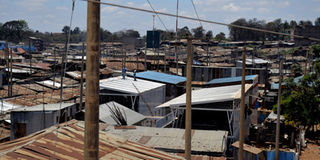22 million Kenyans languish in poverty

Mathare slums in Nairobi on September 24, 2014. PHOTO | SALATON NJAU
What you need to know:
- According to the report, rural areas, which account for 75 per cent of the total population, have poverty levels of more than 55 per cent. Further, the report says that about 21 per cent of rural households use poor faecal disposal methods such as buckets and the bush.
- The number of those who live below the poverty line is on the increase, even as absolute poverty declined slightly between 2009 and 2013.
- According to the findings by the Kenya Institute for Public Policy Research and Analysis (Kippra), counties such as Kitui, Marsabit, Mandera, Samburu, Tana River, Turkana and West Pokot have poverty levels above 70 per cent.
More than 21.5 million Kenyans are languishing in poverty, with Turkana County having the highest number while Kajiado has the lowest.
Nairobi, Kirinyaga, Kiambu and Meru counties are also among those with the least number of people living below the poverty line.
According to the Kenya Economic Report 2014, population is another emerging factor that continues to create havoc in the economy and may soon turn into a crisis, if not controlled.
The number of those who live below the poverty line is on the increase, even as absolute poverty declined slightly between 2009 and 2013.
Although Nyamira County is considered agricultural, the research findings reveal that the county is among the poorest in Kenya, at number 12.
According to the findings by the Kenya Institute for Public Policy Research and Analysis (Kippra), counties such as Kitui, Marsabit, Mandera, Samburu, Tana River, Turkana and West Pokot have poverty levels above 70 per cent.
These counties are also characterised by relatively weak infrastructure and poor access to public services.
RURAL AREAS
According to the report, rural areas, which account for 75 per cent of the total population, have poverty levels of more than 55 per cent. Further, the report says that about 21 per cent of rural households use poor faecal disposal methods such as buckets and the bush.
The report reveals that rural-urban migration has been on the rise over the years, making living conditions in towns a problem.
Currently, there are more than 13 million people spread across different towns, with Nairobi leading at slightly over 3.6 million inhabitants followed by Mombasa with over 1 million. The report reveals that Ngong has the lowest population of urban dwellers, with slightly more than 120,000.
The report says agriculture is declining compared to other sub-Saharan African countries. “Explanations include climate variability and droughts,” says the report.




